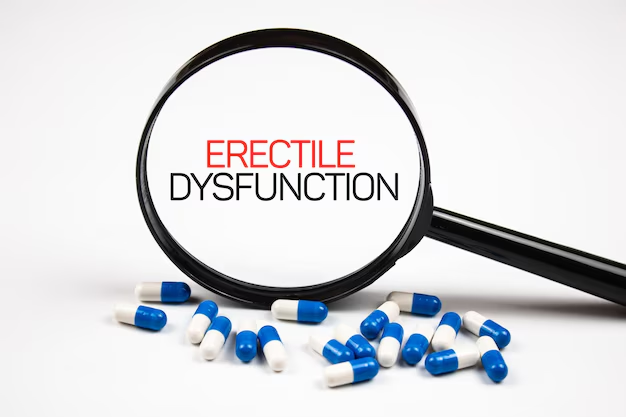What Is a Erectile Dysfunction (ED)?
Erectile dysfunction (ED), formerly termed impotence, is defined as the failure to achieve or maintain a rigid penile erection suitable for satisfactory sexual intercourse. While no specific time is part of this definition, some have suggested that the condition needs to persist for six months. ED is a common condition in men who are 40 years and older; prevalence increases with age and other co-morbidities.
ED can be a symptom of a wide range of underlying pathologies and is an essential but underutilized cardiovascular risk factor. Any disease process that affects penile arteries, nerves, hormone levels, smooth muscle tissue, corporal endothelium, or tunica albuginea can cause erectile dysfunction. This condition is closely related to cardiovascular disease, diabetes mellitus, hyperlipidemia, and hypertension, among other disorders. Endothelial dysfunction appears to be the other common pathway in patients with this condition.

While the vast majority of patients with ED will have organic disease, some may have a primary psychological issue, particularly younger men. Even when the underlying cause is organic, there are almost always psychological consequences to ED regarding marital and relationship issues, cultural norms and expectations, loss of self-esteem, shame, anxiety, and depression, among others. ED can cause considerable emotional damage to the patient and their partner, as well as have a significant impact on their quality of life. Fortunately, ED is almost always treatable.

What caused ED?
The cause of ED is often multifactorial. Distinguish whether the condition has an underlying psychological cause or an organic etiology. Depression, performance anxiety, and other sexual disorders can be strong contributing factors even when organic causes also exist. Aging is an essential factor contributing to ED. As patients age, cardiovascular diseases, hypertension, and other co-morbidities play an increasingly significant role in this condition. Diabetes mellitus and metabolic syndrome can affect several organ systems, resulting in the accelerated deterioration of erectile function, and can disrupt the mechanisms underpinning erections on a molecular level.
Other causes of ED include neurological diseases (such as multiple sclerosis), hormonal causes (hypogonadism, thyroid), traumatic (eg, pelvic fractures, spinal cord injuries), hyperlipidaemia, stroke, sleep apnea, COPD,
glaucoma, multiple sclerosis, sequela of priapism, depression, prostatic hyperplasia with lower urinary symptoms (BPH with LUTS), iatrogenic (eg, post transurethral resection of the prostate) and a variety of medications (antidepressants, antihypertensives, antipsychotics, opioids, and recreational drugs)
Cardiovascular Disease and Erectile Dysfunction
Cardiovascular disease is a very significant risk factor for ED. Almost 50% of men with known coronary artery disease proven by cardiac catheterization have significant ED. Part of the reason for this is that the coronary arteries and the penile cavernosal arteries are similar in size and tend to develop atherosclerotic problems similarly. Since the cavernosal arteries are small, they can develop blockages from atherosclerotic plaques earlier, resulting in vasculogenic ED years before the clinical appearance of coronary artery disease. Both cardiovascular disease and ED involve endothelial cell dysfunction in their pathophysiology.
Patients will often demonstrate subclinical atherosclerosis long before any overt ED by as much as 10 years. The cavernosal arteries being of smaller diameter means that vasculogenic ED often precedes coronary artery disease, myocardial infarctions, and strokes by up to 5 years.Younger men who present with unexplained ED appear to have a very significant increase, up to 50-fold, of their cardiovascular risk in later life compared to an age-matched control group. Inform patients that ED is a significant indicator of underlying heart disease and refer them for further cardiovascular risk screening and treatment.
The Risk of Having ED
The Prostate Cancer Prevention Trial database showed that having ED increased a patient’s cardiovascular risk roughly equivalent to the risk of smoking or having a family history of myocardial infarctions. A meta-analysis of 14 studies totaling over 90,000 men with ED found that these patients had 44% more cardiovascular events, 62% more myocardial infarctions, 39% more strokes, and a 25% increased risk of death compared to patients presenting without ED.
ED has useful independent predictive value for future cardiovascular events; therefore, screen all patients with ED for cardiovascular risks. If cardiovascular risk is intermediate, perform non-invasive testing for subclinical atherosclerosis and an exercise stress test, but if the patient has a high risk, recommend a formal cardiology referral.
Besides cardiovascular disease, there are strong correlations between ED, hypertension, hyperlipidaemia, diabetes, hypogonadism, obesity, smoking, alcoholism, benign prostatic hyperplasia (BPH) with lower urinary symptoms (LUTS), depression, and premature ejaculation.


Treatment Options
There are different ways to treat ED. Your doctor can discuss these with you, and help you consider your individual needs, and the benefits and risks of each treatment option.
- Lifestyle changes like stopping smoking, losing weight, and eating healthier
- Oral ED medications
- Vacuum erection devices
- Injecting medication directly into the penis
- Penile implant: flexible or inflatable
- Artery Reconstruction
%80 of ED is caused by a physical problem or disorder.Proper treatment can
help you return to a satisfying sex life.
Penile Implants
A penile implant is a discrete device that is placed into a man’s penis and is designed to help him get an erection. Once implanted, it helps put the man back in control of his body, and can be used at any time, unlike other treatment options where there may be a short waiting period for them to be effective. A penile implant is an effective solution for men who are suffering from ED that has not been resolved by other available treatment options.
A penile implant involves a specialized surgical procedure. The majority of men can return home within a day of surgery, and after full recovery, may resume sexual activity after 4-6 weeks. Your physician will discuss the details of the procedure, your recovery process, and using the implant. Penile implants have been a safe and effective standard of care for men suffering from ED for many years, and can offer hope and a return to intimacy and a normal life for many men with ED.

There are two types of penile implants:
Inflatable penile implant produces a controllable erection that acts and feels
more like a natural one.
Flexible penile implant produces a permanently firm penis and may be appropriate for men with limited hand dexterity.
Both types of penile implants are totally concealed in the body, and give a man with ED the ability to have an erection – instantly, whenever the time is right, for however long he and his partner want. It helps put the man back in control and back to a normal life.
Patients report a 98% satisfaction rate 6
for inflatable penile implants

Inflatable Penile Implant
Inflatable penile implant is a self-contained, fluid-filled system made from silicone and Bioflex®, a supple yet durable material. There are three parts to the system, connected by silicone tubing:
The only IPP with a true lock-out valve located at the base of the reservoir.
Designed to emulate the look and performance of a natural erection
Pump design has a non-bulky, low-profile size
When you squeeze the pump bulb, it moves the fluid from the reservoir into the penile cylinders, creating an erection. When you press the deflate button on the pump, the fluid moves out of the penis and back into the reservoir for a natural looking flaccid state.
Flexible Penile Implant
Flexible penile implant that consists of two firm but flexible rods that are placed into the shaft of the penis. There are no other parts to this implant. To have an erection, you simply hold the penis and move it into the desired position. When you are finished, you bend it back down to conceal it.
Features
• Easy for you or your partner
• Good option for men with limited dexterity
• Because it stays firm when not erect, may be more difficult to conceal in clothing

Features
• Easy to use and activate
• One-step deflation
• Not visibly noticeable when flaccid
• Acts and feels more like a natural erection
• Maximizes the girth of the penis
Frequently Asked Questions
Q. Can I have an orgasm with a penile implant?
A. You should be able to have an orgasm with a penile implant if you were able to have one before the implant. Consult your physician about your expected outcome.
Q. What is the recovery time?
A. Everyone is different and recovery time varies, but typically it’s between 4-6 weeks until you can resume sexual activity. Your physician will determine what you can and can’t do during this time. It is important to follow all recommendations from your physician for the best outcome.
Q. Will I lose any length after getting a penile implant?
A. Each penile implant is custom-fitted to your anatomy, and the implant itself does not lead to a loss in size. Depending on your medical history, changes in anatomy or atrophy can result in loss of penile length prior to the implant, and it may not be unusual to lose 1-2 centimeters from your original erect length.
Q. Will anyone notice that I have an implant?
A. The implant is completely placed inside your body. Inflatable penile implant is not
visibly noticeable. The penis appears relaxed and normal when in the flaccid state, and it is not obvious by looking at a man that he has an implant. Flexible rod implant stays firm when not in the erect position, and it may “show” through clothes.
Q. How long does the penile implant last?
A. A study showed that 60% of initial implants would survive 15 or more years without revision or extraction.
Q. Will I be able to have spontaneous erections with a penile implant?
A. It gives you the ability to have an erection instantly any time you want one. However, the implant surgery makes it impossible to ever have a “latent” or natural erection that’s not dependent on the device. Therefore, you should consider carefully whether or not an implant is the right choice for you.
Q. What is the difference between the the two implants?
A. Both help give you the ability to have an erection satisfactory for intercourse. The main difference is that the flexible (malleable) implant that consists of two firm but bendable rods that are placed into the shaft of the penis (corpora cavernosa). There are no other parts to this implant. To have an erection, you simply hold the penis and move it into the desired position. When you are finished, you return the penis to its tucked-down position. You inflate the cylinders by squeezing the pump bulb located in your scrotum, and deflate by pressing the release valve to return the fluid from the cylinders into the reservoir.






